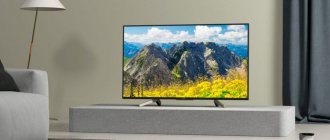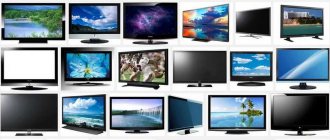TVs with Full HD and 2K resolution have become commonplace. Technologies are developing, people are wondering whether it is worth buying a 4K TV in 2021, how relevant it will be in the coming years and what you can watch on it now
4K resolution or Ultra HD (UHD) is 4096x2160 pixels - this is the screen resolution of the TV receiver. You can watch Full HD on it, but such films will be scaled, causing the picture quality to noticeably suffer.
Let's figure out whether you need to buy a 4K TV now and what you should pay attention to so as not to change the device in 3-4 years. Although during this time technologies will change, and today's flagship will become tomorrow's budget TV receiver.
The resolution of 3840x2160 pixels also applies to Ultra HD, so keep this in mind when choosing a 4K TV.
Upscaling
An image optimized for 4K looks noticeably better.
Image upscaling technology is a must. The software upscales the image resolution, turning 1080p or 720p into 4K or close to it in size.
A powerful processor “completes” the missing pixels based on the color characteristics of neighboring mosaic elements, smoothes transitions, reduces graininess and other distortions.
An image optimized for 4K looks noticeably better, but upscaling technology cannot replace real UHD.
Which player to watch 4K video on?
All the experiments carried out and experiments of viewing 4K on a TV without this option lead to one answer - you need a 4K player - a player that has the Ultra HD playback function built in from the very beginning. This is the only way to see video on the screen with normal sound and without image delays.
If we discard all the additional hardware gadgets that play video files, then the easiest way is to connect a regular flash drive (or removable drive) with a 4K file to the TV. The file was taken as a basis, the data of which is located in the picture below. The picture did not appear on the TV. Therefore, the player on a regular TV cannot cope with this task. It should be noted that the experiments were carried out with a file whose frequency was 30fps.
We tried to download a video to the Dune TV-301 media player. Please note that to receive Full HD video, the adapter from the player or other device with a player to the TV must be digital. In addition to the HDMI connector, you can use DVI. DVI won't handle 4K video, but it can handle Full HD. Dune TV-301 completed the task halfway. The sound appeared for about 5 seconds and disappeared. The image was shown, but with slight inhibition. From the picture you can see that the player itself converted 2160p to 1080p.
The next experiment was playing the file through a Full HD receiver. In this case, there was no image, but the sound was reproduced normally. It's possible that someday there will be updates for these devices with a 4K reading option, but that's not the case yet. Of the listed methods, there is only one way out - buy a player that costs at least $40, or use the option described below.
Diagonal size
The optimal distance for watching movies on a 50-inch TV is 3.7-5 m.
The length of the diagonal is subjective and depends on the preferences of the consumer, his budget and the distance from which he plans to watch TV.
A person with good eyesight should not buy a 4K TV with a diagonal of less than 49 inches and a larger one (52-55 inches) for someone with vision problems.
Also consider the distance to the TV. It is recommended that it be within 3-4 diagonal sizes.
50 inches ~ 125 cm, the optimal distance for watching movies on a 50-inch TV is 3.7 - 5 m.
Is there a need to purchase?
In any case, whether it’s worth overpaying for a 4k TV is up to you to decide. But if you have a large amount of money and want to purchase such equipment, then don’t stop.
Until the Ultra HD standard covers all television broadcasts and Internet video resources, you will find something to watch on your huge screen. Progress moves inexorably forward and in a year or two there will only be more content for 4K.
On the other hand, if you still find it makes sense to buy a 4K TV, you can save money now and in the future. The usual scenario will be the appearance of new Ultra HD models, and, consequently, the price for them will decrease all the time. By moderating your demands in 2019, you will get the desired 4K in 2020 significantly cheaper. And it won’t stand idle most of the time, because the amount of content will increase. Buying a new TV will be 100% justified if your old Full HD breaks down in a couple of years. Then the factors of budget cost and the amount of required content for viewing will coincide.
Backlight type
Budget TVs come with an LED screen - characterized by uniform illumination. There may be glare around the edges, which is why such devices are not in demand.
OLED is an advanced LED backlight, where the brightness of each LED is adjustable. Provides high contrast, deep blacks and better motion blur.
QLED is also an improved LED backlight, where filters consisting of nanoparticles are added. Features high brightness.
Advantages of 4K TVs
Comparatively better specifications are the main advantage that makes many people wonder whether they should buy a 4K TV.
Deeper colors, high contrast levels, image saturation - this catches your eye at first glance.
Other benefits will be visible over time:
- Interpolation (scaling). Allows you to capture small details that are invisible when using Full HD. In addition, tonal transitions are smoothed out.
- High frame rate makes image refresh smooth. 100-120 frames per second in combination with 1200 conventional units of the picture enhancement index will create favorable conditions for long-term viewing - your eyes will not get tired at all.
Content
Watching a movie in Full HD or HD on a huge 4K panel is uncomfortable.
The trend for shooting UHD films was started by Sony in 2011, and every year more and more videos in 4K resolution appear on the Internet. Their market share, compared to FHD content, is insignificant. To appreciate the delights of the UHD matrix, you need video with a resolution of 3840x2160 pixels. And here comes the problem.
There are a lot of 4K videos and films in online cinemas, but cable TV channels do not broadcast in this resolution, and there are no plans for a mass transition to 4K in the next couple of years.
Watching Full HD or HD movies on a huge 4K panel is uncomfortable. Although the image resolution is increased by software, such video processing does not have the best effect on the image quality.
So do you really need a 4K TV? It is only suitable for viewing content in ultra-high definition on the Internet (Amazon, Neflix). Are you ready to pay to watch high-quality but scarce films? No? Then use torrent trackers. You can find a lot of UHD videos there, but you may not find the movie you need.
Cable, digital and satellite TV channels in this resolution are in no hurry to improve the quality of broadcast videos.
Why no one will buy TVs with 4K resolution!
TV has always been perceived by consumers as a thing that will last forever. There was no point in changing TV like gloves. Only black and white on color, and color with a tube on the LCD panel. Nevertheless, TV manufacturers want their products to be bought more, and most importantly, more often, and for these purposes they are constantly coming up with ways to surprise consumers. In recent years, if you remember, such technologies have become stereo and Smart TV (that is, televisions with the ability to install applications and advanced functions). Alas, it’s not that no one wants to sit with glasses and watch a stereo picture; it’s quite difficult to simply get films that are available in this mode, especially online. Therefore, for those who bought such TVs (although now almost all TVs support 3D), stereo glasses usually gather dust in the corner. It's not much easier with Smart TV. Last year, according to statistics, more than half of smart TV buyers have never connected their devices to the Internet. Why? Because a TV is still bought as a TV - as a broadcaster of TV programs, as a device to which you can connect another device, etc. Many people simply try not to press the mysterious button that calls up the start screen of “smart” functions - God forbid something will jump out... And using these functions on TVs from most manufacturers is far from easy. And here is a new “trick”. The 4K format means that the resolution of TVs will increase from the current “ceiling” of 1920x1080 pixels all the way to 4000 by 2000. Before we try to understand what will come of this initiative, let’s take a closer look at what it is. There is really no general standard - there are several standards created by different manufacturers. They promise approximately the same resolution, but, of course, each of them has its own nuances. Where did the idea to make TVs with such a resolution come from? It all started in movie theaters that showed the Star Wars prequels. Lucas shot The Clone Wars entirely in digital at 1080p resolution. For DVD and Blu Ray this was enough, but in cinemas, on giant screens, people in the front rows could see the pixels quite clearly. It was then that the first 4K standards arose - in 2007, cinemas began showing the director’s cut of “Blade Runner” in this format. True, very few cinemas had the necessary equipment. But this is in cinemas. Why do you need 4K at home? Most manufacturing companies have promised to release TVs of this format in 2013. Needless to say, they will be crazy expensive, at least for a few years. What to watch, and why? But let's say you bought yourself a long-awaited 4K panel. And now you are faced with the question: what to watch? Indeed, if you take a sober look at the state of affairs, you realize that there is practically no content with such a resolution. Many TV channels are still broadcast in standard definition, and this is not in Russia. In general, in our country, HD television channels are a separate package for particularly progressive citizens, which is sold on cable networks for some money. How can we not remember that high-definition television began to be introduced a long time ago, and only in the last six or seven years has the purchase of an LCD panel become at least somehow justified. What's the point of buying a huge projection TV for a lot of money if there's nothing to watch on it? Even the quality of the DVD did not justify the purchase of an HD TV, and remember how long the battles raged between Blu Ray and HD DVD! During this time, optical disks have lost their relevance and are perceived by more or less “advanced” people as an annoying atavism. Nevertheless, buyers little by little acquired flat-panel TVs, especially since for some time now quite decent such TVs have been obscenely cheap (although, of course, it depends on who). If you consider, of course, that it is bought to last forever. But the manufacturers don’t want this! And to do this, they definitely need to show TV viewers something new that will make them abandon the TV they bought three years ago. Alas, the bet on the 4K format is completely unjustified, and not just because there is nothing to show on these TVs. First of all, they cost exorbitant amounts of money and will not cost less for a very long time. The displays themselves cost a lot of money and are becoming cheaper very slowly. What can we say about such formats? Here we move on to another interesting nuance of the technology: this very gigantic resolution. The fact is that it will be extremely difficult to enjoy it, even if content is produced for such screens. Imagine a standard family that has a TV in their house, say, with a display of forty inches diagonally. They watch it from a distance of about three meters. No pixels are visible on it from such a distance even when watching TV shows in normal quality; another thing is that the picture itself appears blurry. In standard HD, the picture does not appear blurry. All. This means that no super-resolutions are needed; no one will be able to evaluate them anyway. Of course, another thing is the huge TVs with a diagonal of up to 110 inches, which, by the way, were actively shown at CES. For them, such permission is still justified. Okay, let's say that a spherical consumer in a vacuum has accumulated a seemingly unsustainable amount of money, enslaved his wife and children, and is now getting ready to enjoy his new 4K panel. But it won’t fit into every house and, most importantly, it won’t fit in every apartment at all. So let’s say frankly: no one needs such colossus, or it is needed by a relatively small number of comrades whose standard of living is significantly above average, because such a TV also requires an appropriate home. These are, in fact, all the reasons why almost no one will buy such devices in the near future. And it is important for manufacturers to hook the consumer literally within two or three years, to feed him the idea that he needs such a TV here and now. And they will not be able to do this. However, for example, LG says that this is not the case at all. Three hundred people have already wanted to buy their 84-inch 4K TV, which costs $22,000 (think about that number)! This, of course, should please LG, but there are probably three hundred buyers for any item. Even for gift-wrapped manure that sells for half a million dollars a box.
Source ? I typed it myself!
Smart TV
Even cheap modern TVs come with their own operating system and a radio module for working on the Internet. The Wi-Fi module must support a download speed of 200 Mbit/s and a Gigabit LAN interface. HDMI 2 and CEC support required.
Such devices play streaming video, support watching TV shows online and hundreds of applications (depending on the model and operating system), games and multimedia services. Thanks to the software, the TV can broadcast data stored in the smartphone’s memory: show photos, videos, slide shows.
In addition to the lack of content, the amount of which is constantly increasing, an important drawback of 4K TVs is their price. Don't rush into buying a 4K TV for the future. The number of videos with this resolution is rapidly increasing, but it is still small. And in 2-3 years, when significantly more films, TV series and videos appear in Ultra HD, your expensive purchase will become obsolete.
Pros and cons of 4K
The undoubted user advantages of Ultra HD TVs include:
- The ability to use widescreen 4K TVs for video games, and not just computer matrices (which are in any case smaller than a TV). Such a screen can really immerse you in the world of virtual reality without any VR glasses.
- The Ultra HD matrix is capable of forming a three-dimensional image in the 3840x2160 format, which the viewer can appreciate from any position. Moreover, this stereo image does not require the use of 3D glasses.
- The screen of a 4K TV allows viewing at a relatively short distance. This is due to a 4-fold increase in the number of pixels on the screen. This means that such televisions can already be placed even in small apartments with modest room areas.
However, such technological perfection also has its disadvantages:
- The main disadvantage of 4K television is the high requirements for signal quality. And this, in turn, leads to the fact that today the viewer simply has nothing to watch on such televisions due to the extreme limitation of the content transmitted in this quality. The list of options is in many ways reminiscent of the “menu” of Soviet television; Youtube (it contains selections of films and programs in this quality, designed specifically for 4K TVs);
- Netflix (there are films and TV series focused specifically on the Ultra HD standard, however, subscription to such video products is paid and expensive);
- Megogo (there is a lot of high-definition content available, which can be viewed in Ultra HD format for free).
Elegance is certainly good, but reliability is better
Recently, manufacturers have been focusing on producing ultra-thin models. They look quite impressive on a store shelf, but who cares what a TV looks like in profile when everyone is using the front. Therefore, it’s hardly worth paying extra money for it.
In addition, purchasing a thin TV for a family with children and pets can hardly be called a good idea. After all, their activity can cause a fall of an ultra-thin and light device standing on one leg. And this can lead to its failure. That is, it can simply break. If you really want an ultra-thin model, then at least try to choose one that has at least two fasteners between the case and the stand.
When choosing a TV, special attention should be paid to the presence of a reinforced connector. This becomes very important if someone in the house periodically snags the antenna or HDMI cable with their foot. Replacing the cable will cost much less than repairing the TV board.
What happened to 3D?
In short, it drowned. Consumer interest turned out to be too low, so the 3D format practically left the home market, remaining in cinemas. It’s not hard to guess that many factors led to this: the need to wear special 3D glasses, a darkened or degraded picture (even with the best technologies), and most importantly, mediocre film releases that were hastily converted to 3D. All this completely undermined interest in this feature.
Current model: LG OLED55C6. If you have a collection of 3D films that you want to watch again, and it’s time to update your TV, then you’ll have to look for the remains of the 2016-2017 models. Among the latest TVs with 3D support are the LG OLED55C6 and Sony KD-55XD9305, although most manufacturers have already completely abandoned this function, there is no other way to say it.
Current model: Sony KD-55XD9305.
LED vs. QLED vs. Is OLED even legal?
While OLED technology—a true next-gen—was reaching the mass market, competitors had already managed to creatively tailor the marketing names of their products to this cherished combination of letters. But we will teach you to understand all this.
LED technology
LED TVs, also known as LED LCD TVs, are the most common type today. They are based on a regular LCD panel (most often VA or IPS), equipped with a backlight made of light-emitting diodes (LEDs), which is where they get their name.
This technology is inexpensive to produce, covers all possible screen sizes and has an acceptable image for most viewers. Therefore, it has become the most popular, although largely due to the “cheap and cheerful” segment, where there are simply no alternatives to it.
Where to find? Everywhere! Every company has such TVs.
QLED technology
A logical evolution was QLED TVs and their derivatives, which are structurally very similar to LED LCD (LCD matrix + backlight unit), but a new element was added to the panel - a layer of quantum dots (Quantum Dots). It was they who gave the letter “Q” to the name.
Quantum dots significantly expand the reproduced spectrum, so the colors on such TVs are deeper and more saturated, just right for the HDR format. Their brightness reserves are also increased, and the top models with carpet-backlit screens also have improved black depth.
Otherwise, their characteristics are similar to LED LCDs: the same limitations on viewing angles, the same response times, the same backlight unevenness across different copies, so the most noticeable difference between LED LCDs and QLEDs appears in the HDR format. It’s not for nothing that we said that it is important!
Current model: Samsung QE55Q7F.
Where to find? Generally speaking, the main manufacturer of QLED TVs is Samsung, but such models are in the Hisense and TLC catalog. Similar analogues with quantum dots are also produced by LG, Sony and Philips.
OLED technology
In turn, OLED TVs represent an alternative technology, where each pixel is an independent light source and does not require a separate backlight, unlike the above-mentioned LED LCD or QLED technologies. Hence the lowest panel thickness - about 4 mm.
Due to the complexity and high cost of production, OLED still occupies only the upper segment, but such TVs provide the most vibrant and high-quality picture, regardless of the type of signal. In addition, OLED screens can be combined with a flexible substrate, which allows you to create unique models like a “rollable” TV.
OLED has the highest contrast, free viewing angles, and fast response time. Experts agree that OLED is currently the “Holy Grail” of picture quality, so when choosing a top-end TV, it’s logical to start your search here. Moreover, the price of OLED TVs is often lower than QLED, oddly enough. And you certainly shouldn’t confuse these two technologies: as you can see, they are not the same thing at all.
Current model: LG OLED55B8.
Where to find? The only manufacturer of OLED panels at the moment is LG, but OLED TVs from other brands are also produced on their basis: Sony, Panasonic, Philips. Premium brands Bang & Olufsen, Loewe and Metz have also launched their OLED TV lines in the top segment.
MicroLED technology
MicroLED TVs are a category that is already looming on the horizon, but has not yet reached the masses. In essence, this is the same as OLED TVs, only the LEDs in them are inorganic. In theory, this makes them more stable, durable and potentially cheaper. Although at the moment there is no talk of mass production: modular MicroLED TVs with huge 146″ screens are being prepared for release. It is possible that someday this technology will be able to compete with OLED.











